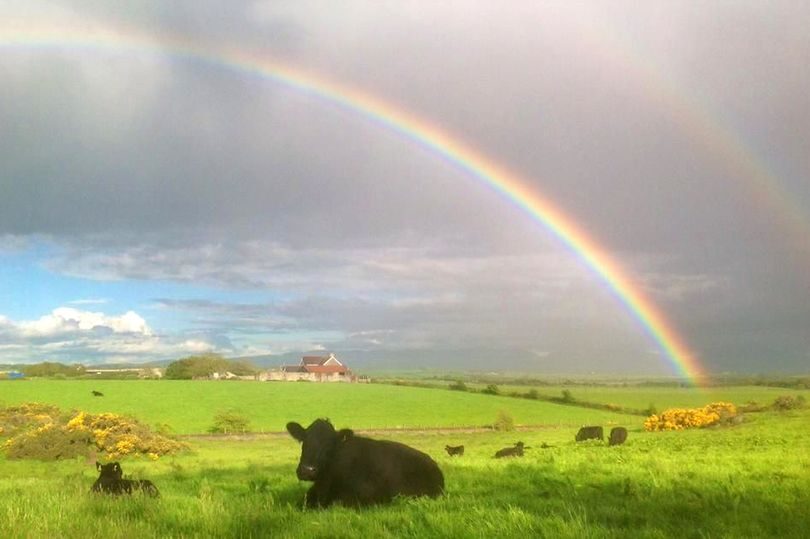
© Ioan RobertsWelsh Black cattle under a double rainbow on Anglesey
A Gwynedd farmer making his afternoon rounds was shocked to come across three cattle killed in a lightning strike. All three had been sheltering under a tree as a "frightening" thunderstorm hit the area on Sunday.
Medwyn Evans, 41, said the Welsh Black heifers were bloated and, when found, had their eyes open. "Being black, I couldn't tell if they had any marks on their bodies," he said. "But their eyes were wide open, as if they had just been struck by a bolt of lightning."
A vet from the farm's practice in Dolgellau was called to the scene and a lightning strike was confirmed as the most likely cause of death. Three other Welsh Black heifers sheltering under the same tree walked away unharmed.
Medwyn, who farms at Gwern Caernyddion, between Llanbedr and Dyffryn Ardudwy in western Snowdonia, said the storm struck at lunchtime. "There was heavy rain and two or three flashes of lightning," he said. "Speaking to neighbours this morning, they said it was quite frightening, they'd not seen such an intense storm for a long time."
As the rain cleared, he went to check on his heifers in a field about a quarter of a mile from the farmhouse. He believes the three dead animals were "unlucky" as they just happened to be standing in the wrong place at the wrong time.
"The tree they were under has three main branches and half the heifers were by the lowest one," he said. "They must have been in contact with it and that's why they were killed."
There have been no known lightning strikes in the immediate area where the animals were killed. However the herd lost a cow this way around 15 years ago on another part of the farm further away.
"That area is a notorious lightning line," said Medwyn. "There are old manganese mines nearby, and maybe the metal attracts lightning, I don't know."
Lightning strikes on cattle are not common but reports from around the world suggest livestock can be vulnerable in thunderstorms. Last year eight heifers were killed by lightning in central Maine, USA, and in 1998, 15 cows sheltering beneath two trees in Co Tipperary, Ireland, suffered the same fate.
One of the worst incidents on record occurred almost exactly a year ago when a lightning strike killed 42 cows and knocked their owner unconscious in southern China. Although the animals were in a field at the time, the incident was blamed on "metallic components" in a rudimentary shed nearby.
Death from a lightning strike is almost always instantaneous. Cattle are often found with grass still in their mouths. Most have singe marks, usually on the insides of the legs. Bloat is common but differs from that caused by diets.
Medwyn runs about 50 pedigree Welsh Black cattle under the Gwern-Caernyddion fix. He is the son of Robert Evans, one of three brothers who, in 2019, became the first trio of siblings appointed joint presidents of the Welsh Black Cattle Society.
The sheltering heifers had been selected as replacements for the herd and were due to be put to a bull this summer. Medwyn said: "The three that died were more or less the best we had.
"It is quite a loss - when something like this happens, there's always a risk the herd quality goes down. But things like this happen when you are farming, you just have to get on with life."

Reader Comments
to our Newsletter